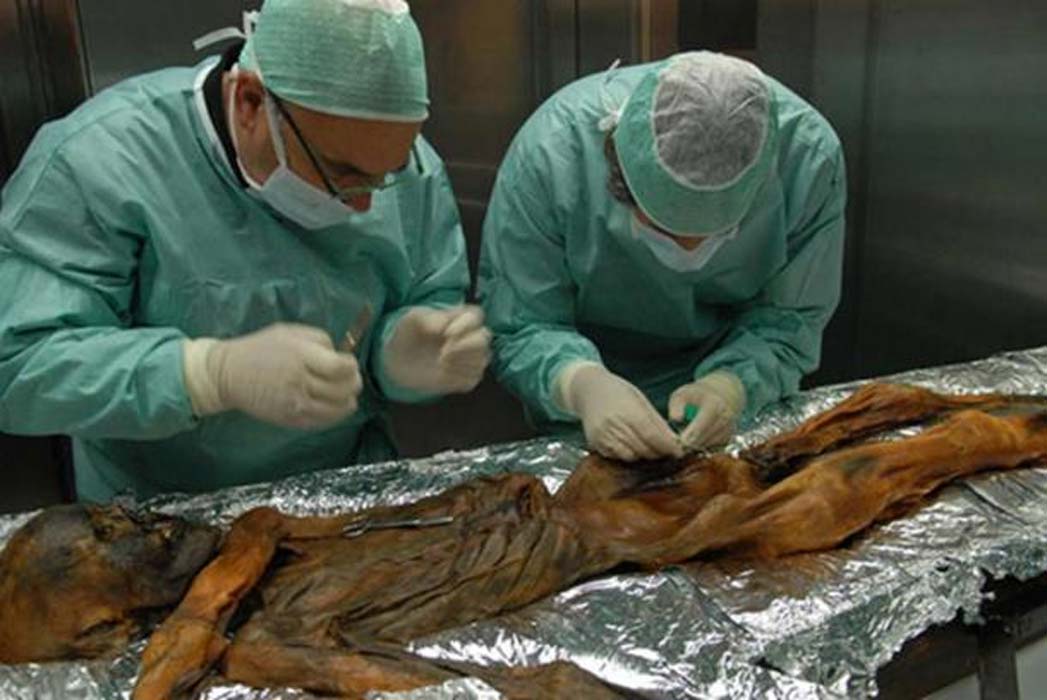Ancient Murder Victim Had A Very Heavy Heart!
In 1991, hikers in the Italian Alps near Similaun mountain on the border between Austria and Italy discovered a 5,300 year murder victim, now known as Ötzi, who is now housed at the South Tyrol Museum of Archaeology in Bolzano, Italy. It is known he died with an arrow lodged in his shoulder and had been smashed in the head with a blunt weapon. But now, according to a study published in the Journal of Advances in the field of X-Rays, scientists have discovered that Ötzi was “a heart attack waiting to happen.”
The Postmortems of Ötzi
Ötzi has been extensively microscopically examined, measured, X-rayed and dated and in this most recent study researchers completed “a head-to-toe CT scan” in a large scanner at the Central Hospital in Bozen-Bolzano allowing them to pinpoint a range of hardened plaques around his arteries. Eating a diet of too many fatty meats, Ötzi suffered high cholesterol levels and blood pressure and had a poor cardiovascular health. A Live Science article detailed the results of the “full-body computed tomography (CT) scan” which revealed that Ötzi had three calcifications (hardened plaques) around his heart putting him at increased risk of having a heart attack.
- Stomach Troubles for the Iceman: How Otzi Continues to Provide Information About the Past
- Were the tattoos of Ötzi the iceman therapeutic?
- Otzi Speaks: Scientists Reconstruct Voice of 5,300-Year-Old Iceman

A reconstruction of Ötzi mummy as shown in Prehistory Museum of Quinson, Alpes-de-Haute-Provence, France. (CC BY-SA 3.0)
Dr. Seth Martin, a preventive cardiologist at Johns Hopkins Medicine in Baltimore told reporters at Live Science that “having further calcifications in the carotid artery” which channels blood to the brain, Ötzi was also at an increased risk of a stroke. Martin added that if Ötzi had lived today and doctors caught his condition before he had a heart attack or stroke, they might give him “coronary bypass surgery to divert blood flow around the blocked artery, or a carotid endarterectomy which surgically cleans the carotid artery to help prevent stroke.”
Live Science previously reported that Ötzi had a “genetic predisposition for atherosclerosis,” which is a narrowing of the arteries caused by fatty deposits. Albert Zink, the head of the Institute for Mummies and the Iceman at the European Academy, supported this diagnosis telling reporters that “Ötzi had calcifications in his heart, which indicates a more advanced atherosclerosis with an increased risk of stroke or heart attack.”
Cardiovascular Issues
It is impossible to ascertain exactly when human civilization first became aware of coronary artery disease (arterial narrowing) but according to a BBC science article it was Leonardo da Vinci (1452–1519) that first investigated coronary arteries. King Charles I’s physician, William Harvey (1578–1657) is credited with first observing that blood circulates the body from the heart and according to the book Drug Discovery: Practices, Processes, and Perspectives Friedrich Hoffmann (1660–1742), chief professor of medicine at the University of Halle, noted that coronary heart disease was a “reduced passage of the blood within the coronary arteries.”
- Ancient Medical Knowledge Is Written in the Skin
- What the ancient Mayans can teach us about health and healing
- New study sheds light into ancient Egyptian health care system at Deir el-Medina

Portrait of William Harvey, physician to King Charles I. (Public Domain)
Aiming to fill the gaps in our understanding of the history of heart disease, a Science Daily article reported on a 2009 American Heart Association meeting in Florida, where researchers presented their results of tests on 3,500 year old Egyptian mummies, some of which also had evidence of atherosclerosis. Pharaoh Merneptah who died in the year 1203 BCE was found to have suffered atherosclerosis and researchers theorized that “diet could be involved.” High-status Egyptian rulers and priesthoods ate a lot of fatty cattle, ducks and geese.”

Head of mummy of pharaoh Merneptah. These mummies didn’t start out quite so emaciated. (Public Domain)
Ancient Health Lessons from Ötzi
So what can we learn from Ötzi’s terrible cardiovascular health? According to an article in the Lancet journal, in 1948 the National Heart Institute conducted the Framingham Heart Study, the first major study to help us understand heart disease. In the early 1950s, University of California researcher John Gofman identified the two cholesterol types and discovered that men who developed atherosclerosis commonly had elevated levels of LDL and low levels of HDL cholesterol.
Also in the 1950s, American scientists Ancel Keys (1904–2004) travelled around Europe and noted that heart disease was “rare in some Mediterranean populations where people consumed a lower fat diet.” He later noted that Japanese people had low-fat diets and low rates of heart disease causing him to theorize that saturated fat was a cause of heart disease which has led to governments attempts at urging people to change their diets for better cardiovascular health.

Reconstruction of Ötzi perhaps has him a bit on the lean side. (CC BY-SA 3.0)
It would appear that if Ötzi had lived further south and had a different diet, he might not have suffered his cardiovascular problems. Dr. Philip Green, an interventional cardiologist at New York-Presbyterian told Live Science “I think a different diet, such as vegetarian or vegan, wouldn’t have helped Ötzi.” It seems there is no escaping the fact human beings are designed to consume calories and to burn it off. It seems that the problem lies in which type of calories we consume, and when we get this wrong, nasties take hold of our hearts.
Top image: Researchers take a sample from Iceman's hip in 2014, which revealed a genetic disposition for cardiovascular disease. Image credit: Samadelli Marco/EURAC
By Ashley Cowie



















